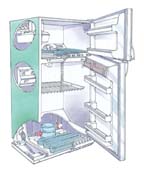
Adhesives are widely used in appliance manufacturing, providing solutions for structural bonding, cylindrical assembly, threadlocking, flange and thread sealing, thermal management, wire bonding and harnessing, gasketing, sealing, and a range of other design challenges. The ability of adhesives to bond dissimilar materials, reduce component inventory and decrease total manufacturing costs has enabled the production of many appliance designs that would have been impossible or cost prohibitive to develop through the use of mechanical fastening methods only.
The Henkel Innovation Center is a facility where the latest appliance designs are torn apart in order to analyze and solve an OEM's performance and cost concerns. Appliance design, manufacturing and materials engineers partner with similar contacts from Henkel to get a full picture of manufacturing processes and costs.
To prepare for the teardown session, the participating appliance OEM dedicates knowledgeable members of their engineering team and provides the appliance to be disassembled. The OEM also provides drawings and schematics of the appliance, a product manual, a production model, and a process schematic that illustrates each step in the manufacturing and shipping process.
Prior to the actual teardown, the Henkel/OEM team meets to identify manufacturing problems and process bottlenecks related to the specific appliance. The team brainstorms for new design, process improvement and cost reduction ideas. Henkel contacts try to uncover any unrecognized needs.
The primary goal of any appliance teardown is to identify cost saving opportunities for the OEM. Cost savings may be recognized by eliminating inventoried parts, streamlining the overall production process, or finding ways to automate steps that previously required manual coordination.
Representatives from the Henkel Innovation Center recently partnered with refrigerator manufacturers to examine and identify cost savings on top-mount and side-by-side models. The adhesives used in the production of the refrigerators included hot melts, UV acrylics, cyanoacrylates, silicones, anaerobics, butyl tapes, pretreatments and drawing lubricants.
Refrigerator disassembly was broken down into five component subcategories: cabinet, doors, liner assembly, electrical and shelf parts. The team evaluated each component and sorted potential applications as high, medium, or low priority. Applications that were strong candidates for conversion to adhesive/surface technology treatments were identified as high priority. Initial plant audits identified several high priority manufacturing bottlenecks. Examples of high priority applications follow.
Cabinet Parts
To protect finished refrigerators from damage during shipping, protective foam corner posts were manually taped onto the four painted corners of all refrigerator units. The taping process was labor intensive and costly, requiring several operators to hold the posts in place and complete the taping. Henkel engineers suggested replacing the tape with an adhesive that would bond well to the specified foam, but remove easily from stainless steel and polyester painted surfaces. Requiring just two shots of adhesive per post, two posts could be bonded to the refrigerator unit in just 12 seconds.Manufacturers are looking for a new way to bond product identification nameplates made of a synthetic single layer film onto the polyester-painted refrigerator doors. Double-sided adhesive tapes were not an option as they would be visible through the film substrate. Henkel engineers suggested formulating a clear adhesive that would adhere to the film and the polyester paint, and agreed to design the dispense process to apply the adhesive to the label.
Liner Parts
Manufacturers are using cut gaskets to serve as an electrical shield and a moisture seal between the control box and the top liner of the refrigerator. The shields are being riveted and screwed to the refrigerator's top liner. In order to eliminate costly cut gaskets and rivets, and to speed the assembly process, Henkel engineers recommended using a structural adhesive to act as a gasketing material that would bond the aluminum to the high-impact polystyrene liner, saving processing time and reducing parts inventory.Shelf Parts
For newly designed, shelf-mounted interior lights, manufacturers needed to specify a material to seal the ABS/PVC electrical connector so that it could be overmolded to a plastic shelf. To meet the application requirements, Henkel engineers specified a non-sag, thixotropic potting material that would protect the connector and allow a safe electrical connection to be established in the middle of the refrigerator interior.Conclusion
In total, 14 cost-saving applications were identified within the two refrigerator models studied. The overall teardown process required a commitment of approximately 12 hours from manufacturers and Henkel. Once the teardown is completed and recommendations are made, representatives from manufacturers and Henkel work together to find the correct adhesive to meet specific application requirements. The follow up on this teardown is ongoing and will conclude approximately 12 months after the teardown process began.For more information, contact Henkel Corp., 1001 Trout Brook Crossing, Rocky Hill, CT 06067; phone (860) 571-5376; fax (860) 571-5430; or visit http://www.henkel.com .
Adhesive Applications in Refrigerator Assemblies
The image above illustrates the inner workings of a typical refrigerator. On this appliance, cyanoacrylates are used to bond door handles and shelves, and to touch up switches; to attach ID tags on the compressor motor; and for plastic bonding applications. Cyanoacrylates are being used in glass-to-glass bonding of large shelf assemblies located inside the refrigerator.Refrigerator manufacturers rely upon anaerobic adhesives primarily in motor assemblies where the adhesives function as threadlockers to secure bolts and screws, thread sealants that protect against harsh chemical refrigerants, and retaining compounds that bond commutators.Threadlockers are also used on threaded assemblies located throughout the appliance.
Silicones are used to seal the door gaskets and for a variety of gasketing applications. Hot melts seal the bottom edges of the door assembly, acrylic adhesives are used for motor magnet bonding, and light-cure adhesives bond plastic and metal trim to glass shelves.


